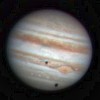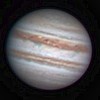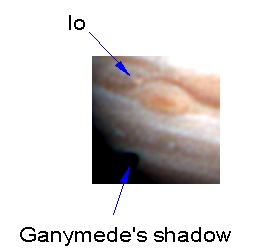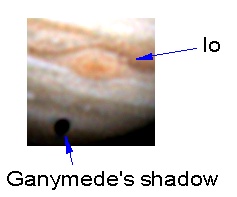

On January 7, 2001, Jupiter put on a great show: both Io and Ganymede transited Jupiter, followed by their shadows, all accompanied by the Great Red Spot. The seeing was variable for this event, but I was able to capture it all in a long movie. I took high-resolution color images as fast as I could (one R-G-B sequence every 89 seconds) for a total of 7 hours. Jupiter disappeared over the neighbors house, preventing a full 10 hour rotation, but this is a good practice for a better movie next year, with a better telescope mirror.
Each image was composed of separate, consecutive 4 second exposures through red, green, and blue filters with an SBIG ST-7 CCD camera and CFW-8 filter wheel. The telescope is a 10" Newtonian (masked to 9" to help salvage a badly turned edge) operating at about F/60 through a Stellar Products AO-2 adaptive optics image stabilizer. The images were processed with MaximDL maximum entropy deconvolution, mild unsharp masking, aligned and converted to RGB files. The images were then shrunk by a factor of two and compressed to jpg files. After aligning all 290 color frames, I enhanced the images a bit more by using a rank filter and increasing the color saturation a bit more. I tried to bring out as much detail as I could without generating false artifacts.
While some frames have sub-arcsecond resolution, at times, clouds limited the signal to only 1%, and sometimes the seeing deteriorated to several arcseconds. Since the sky varied during the different exposures for each color, balancing the color and contrast for each final frame was a challenge! For a few frames, I replaced the worst raw images with the average of the neighboring frames; this way, the movie looks continuous (except for the jumping-moon effect).
The movie was made in three versions; the largest file probably needs a high-speed internet connection. Click on the images to bring up the movies. Hint; set your image viewer to continuous loop mode, if possible (look carefully at its options): it really enhances the movie play to have it keep going around and around.


Because of the long sequence, the difference between the rotational periods at the equatorial regions compared to the polar regions becomes evident. Unfortunately, a complete rotation was not quite achieved, so distinct features at the start of the movie are not quite back into view 7 hours later.
As an example of the high resolution, Io can be seen crossing the Great Red Spot in these two enlargements, taken at 6:48 PST and 7:51 PST.


All text and images are owned by Stellar Products, 1992-2003. Any use by others without permission of Stellar Products is prohibited.
Links to other Stellar Products pages: